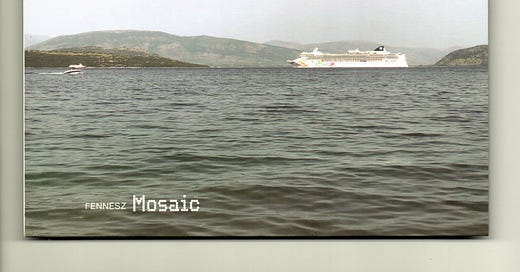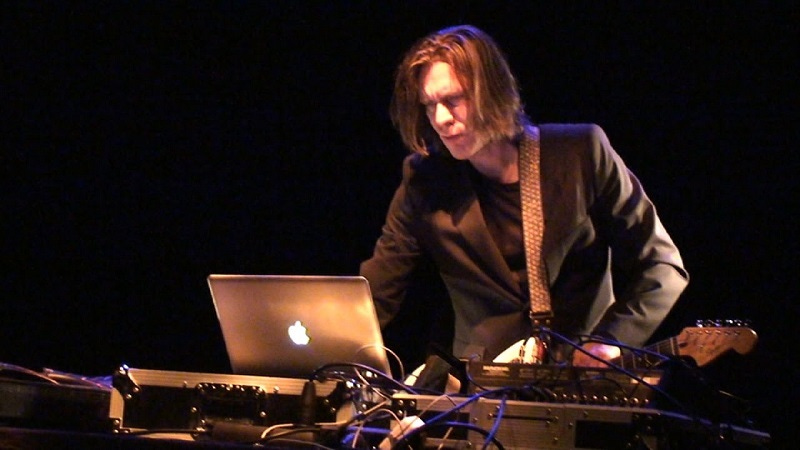Neuguitars 2025 #11 Mosaic, Fennesz and Rediscovered Serenity: A Symphony Between Analog and Digital
Mosaic | Fennesz on Bandcamp
TO:125 | Fennesz – ‘Mosaic’ | Touch
There are different types of musicians: virtuosos who elevate instrumental technique to exceptional heights; educators who are able to pass on their knowledge to new generations; and experimenters, those who venture down unexpected paths, capable of opening new musical frontiers and carrying their instrument into an unimaginable future. Christian Fennesz belongs to this latter, select category.
Fennesz, one of the very few musicians instantly recognizable by surname alone, is a pivotal figure in the landscape of contemporary experimental electronic music. Born in Vienna in 1962, he became renowned for his ability to blend organic and digital sounds, transforming the electric guitar, a traditionally rock-associated instrument, into an abstract, dense, granular, and at times intangible sound source.
I mentioned unexpected paths earlier. Fennesz is one of those rare musicians who plays his instrument, the electric guitar, not only outside traditional and genre clichés but as a pure sound generator: a material to be shaped, manipulated, deconstructed, and reconstructed through masterful use of laptops and audio processing software. With Fennesz, the electric guitar becomes a pure sonic language. Despite his roots in guitar tradition, he studied music and played in rock bands early in his career, his approach is marked by a radically innovative vision.
My first encounter with Fennesz’s processed guitar was in 1998, in the studios of Radio Base Popolare in Mestre, where I was helping some friends with their radio program White Noise, a show dedicated to frontier music, something I enjoyed immensely.
One evening, a friend (I can't remember who) brought in a CD inside a white, red, and black cardboard sleeve featuring a palm tree with a prohibition sign over it. The listening experience left us all stunned. It was PLAY, a mini-CD released by Mego containing two covers: “Paint it Black” by The Rolling Stones and “Don’t Talk (Put Your Head On My Shoulder),” which, though we didn’t know it at the time, foreshadowed Endless Summer, an album that would be hailed as a miracle a few years later.
Listening to both tracks again more than 20 years later, they haven’t lost a single ounce of the creative spark that struck us back then. They still stand as milestones of high-level artistic exploration.
In albums like Endless Summer (2001), now considered a classic of 21st-century electronic music, Fennesz managed to deconstruct the electric guitar, making it sound like a sea of digital waves where timbres dissolve into one another amidst distortion, glitches, and endless reverberations. Using software like Max/MSP and plug-ins like GRM Tools, Fennesz treated the notes from his guitar as if they were pigments on a canvas: layering, blending, and degrading them until they became unrecognizable. Yet, the human presence of the instrument never fully vanished. Even at its most abstract, the guitar remained the beating heart of the sound, a melodic ghost surfacing and disappearing among digital noise.
Endless Summer was a masterful allusion to the nostalgia of a lost, endless, unreachable pop summer. We were deep in the “glitch” era, and discovering a guitarist who could evolve its icy aesthetic using guitar-generated rather than synthetic sounds was a delightful surprise.
Fennesz isn’t a particularly prolific musician; he carefully curates each of his works with obsessive attention to detail. On December 6, 2024, five years after Agora (2019) and ten years after Bécs (2014), he once again immersed himself in the sea of sonic fragmentation, one of the hallmarks of his style. The result is a sound that is nothing short of sumptuous and intricate, blending elements of noise and ambient over which an abstract guitar drapes, barely recognizable. Mosaic can be seen as a paradigmatic example of Fennesz’s poetics.
Mosaic is a title that perfectly reflects his compositional approach. Like a mosaic, its tracks are made of fragments: tiny samples, distorted harmonies, glitches, reverb, and delay that coalesce into a cohesive, intentionally imperfect, emotionally charged, and poetic soundscape.
Mosaic displays a baroque kaleidoscope of sounds and driving guitar harmonics, infused with the enthusiasm for glitch aesthetics, sonic fragmentation, and digital noise, while retaining Fennesz’s signature taste for subtly hidden melodies within the dense weave of digital textures. At the same time, I would describe Mosaic as the album of his artistic maturity. While it reaffirms the expressive coordinates of his recent years, it also reveals a serene, non-conflicted relationship with time.
The compositions unfold slowly, without marked rhythmic structures. The sounds layer, dissolve, and chase one another in a space that seems to expand and contract like a breath. Fennesz uses time not to build traditional climaxes, but to sculpt perception: each moment is a suspension, an echo, a nuance. Listening becomes a meditative act, an immersion in a sonic flow that invites stillness and introspection.
Mosaic is also, and perhaps most importantly, a deeply emotional work. The tracks, despite their abstraction, convey precise feelings: melancholy, nostalgia, calm, solitude. This is likely due to Fennesz’s ability to fuse acoustic elements (the guitar, submerged melodic tones) with granular electronics, creating a tension between warmth and coldness, between organic and digital. In this sense, Mosaic can be read as a sonic reflection on the contemporary human condition: fragmented, complex, yet not devoid of beauty or meaning.
The result is one of the most immersive and intimate journeys he has produced to date—a striking example of complex sonic expressionism, composed of delicate chromatic layering, a kind of intricate baroque counterpoint where vivid colors alternate with sharper harmonic lines. This is because Fennesz’s music lives in a constant balance between the organic and the synthetic, between melody and noise. His compositions evoke soundscapes more than conventional musical structures. It’s music meant to be listened to attentively, that demands time, but which can also be profoundly emotional.
As I mentioned earlier, Fennesz is also a master of time and space: he knows when to let a sound expand and when to cut it short, creating dramatic tension within his compositions.
His impact goes far beyond the world of electronic music. He has helped redefine the very concept of musical sound, paving the way for a more fluid, hybrid, and experimental approach to composition. In an era where genre boundaries are increasingly blurred, Fennesz stands as a true forerunner of this dissolution.








